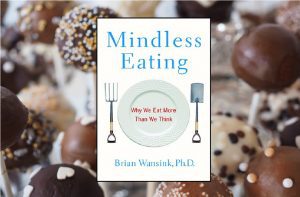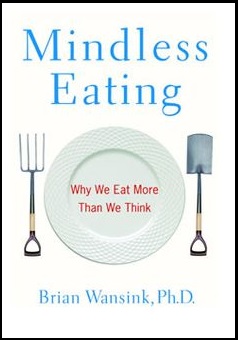Has your weight slowly crept up over the last few months and years? Would you know if you had eaten 100 calories too many today? How about 100 calories too few?
Brian Wansink is a PhD researcher who has set up hundreds of studies to determine our eating habits. He reveals some very worrying trends about how the environment around us influences our food choices and, more importantly, portion size. His famous “popcorn study” is one of many that show how we unconsciously manage to take on too many calories in every day situations. Just 100 calories too many and you end up putting on around 1lb a month of fat, and you don’t even know it’s happening! The good news is that by learning all the tricks your mind plays you can make it work for you not against you and use it to lose 1lb a month.
Book seven is…
Mindless Eating by Brian Wansink
PRO TIP: Take notes! When you read a book, use a blank sheet of paper as a bookmark. Write down any interesting facts and information from the book. This condenses a whole book into 3-4 pages of key notes that are important and relevant to you.
My Notes
- A free popcorn study, using stale popcorn in two sizes, showed a larger container led people to subconsciously eat 53% more calories.
- Almost any food sign in a shop with a numerical discount resulted in 30-100% more sales.
- We can only consistently lose 0.5-1lb a week on a diet. Any more involves losing muscle, slowing down metabolism.
- Since we can’t notice if we ate within 100 calories of target, we are open to long term weight gain.
- As there are 365 days a year then 10 extra calories a day can alter your weight by 1lb/year.
- Most people could make a meal 20% smaller and not notice. In this way we eat until 80% full, not stuffed.
- Cues for weight loss other than the scale include visible cheekbones and fitting into certain clothes.
- People eat the same volume of food every day, not calories. Make your food bigger but not more calorific by adding greens.
- Using a re-fillable soup bowl, people ate 73% more, showing they use “plate is empty” to replace the cue “am I full?”
- We prepare up to 23% more food if the packages we have are larger. This effect is from skewing our idea of a ‘normal’ portion e.g. a jumbo box of cereal
- Inverted T illusion makes us notice height over width. This means if we pour into a short fat glass of coke we’ll drink 20% more than a tall and thin one.
- The Size-contrast illusion (below) proved that a smaller plate led to smaller portions.

- Increased variety of food at a buffet leads us to eat more. This is because we have different hunger levels for different tastes.
- It’s a good idea to downsize dinner plates and re-package food that’s in jumbo packs.
- If unhealthy food is more visible, you will think about it more. Hide bad foods.
- If you come home via a back door and pass through the kitchen, you will believe you are hungrier than if you avoid it.
- Eating with friends and family turns them into pacesetters. We tend to mimic how fast they eat and continue eating until all have finished. We also don’t keep track of food intake as we’re distracted by the conversation.
- When people watched TV while they ate the consumed more calories.
- Obese people are likely to judge meals based on what time it is (i.e. it’s lunch time). This is in contrast to people of normal weight who base it on hunger levels. This was demonstrated in an experiment where the clock in the room was sped up. Obese subjects increased their meal frequency, believing it was time to eat again.
- Bright lights, hard surfaces and loud colour schemes of fast food restaurants encourage you to eat faster. This causes you to over-eat, as the signal from your stomach to your brain telling you to stop eating takes 20 minutes. That’s why you can eat to the point of discomfort and then still feel worse soon after.
- Some soup companies run adverts when it’s cold or raining as they know consumers see soup as warm and comforting.
- Research showed a fancier sounding name lead subjects to believe the same meal tasted better.
- The phenomenon of “expectation assimilation” is where something is simply described as tasty lead subjects to rate it as tasting better. The study also showed that constantly telling someone they are eating a strawberry yoghurt led them to taste it as such. The yoghurt was actually chocolate flavoured.
- Expectation assimilation is how branded products command a bigger market share. Simply believing a food product is higher quality means it physically tastes better to us.
- We develop positive associations with foods used to “celebrate”. For example, when we need cheering up we might turn to chocolate and cake. This is because they feature on joyous occasions, such as birthdays.
- If you’re overweight, your child has a 65-75% chance of being overweight.
- People will eat 50% more of a snack food if it’s labelled “low fat”. This was true even though the “low fat” version only had 10% fewer calories.
As someone who really enjoys psychology this book was a real treat for me. When you combine all these mental traps you can see how the general population can steadily over-eat their way to an obesity epidemic. The increased prevalence of “distracted” eating, i.e. eating while doing another activity, is one of many ways we’re subconsciously consuming too many calories. If you want a simpler solution than changing your diet and exercising, I recommend this book. Simple tricks like down-sizing your crockery could be all you need to control portion size and improve your health.


